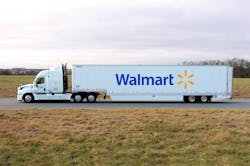With over 6,300 Class 8 tractors and approximately 60,000 trailers located throughout the United States, the Walmart truck fleet reaches far and wide. Walmart as a company reaches much further. That is why sustainability has become such a key goal for the company, which became the first retailer to sign on to the Science Based Targets Initiative in alignment with the Paris Climate Agreement in December 2015.
Walmart has committed to acquire half of its energy from renewable sources, reduce emissions in its own operations by 18% by 2025, and work with suppliers to reduce emissions by 1 gigaton by 2030.
But before it committed to these latest environmental targets, Walmart had goals to achieve by 2015. Those goals, launched officially in 2005, featured a range of efforts across the entire business, transportation included.
“Transportation is one of the cogs in a very big wheel,” says Elizabeth Fretheim, director of logistics sustainability. “When we make changes, it affects things upstream and downstream [in the supply chain]. We need to work together as an industry” and collaborate with suppliers, government, manufacturers, and fleets.
The initial sustainability goal was to double U.S. fleet efficiency by 2015. In October of that year, Walmart announced the fleet had met that goal, reducing CO2 emissions by nearly 650,000 metric tons a year and saving $1 billion in costs in fiscal year 2016.
To accomplish this, Fretheim says the fleet focused on three core areas: filling trailers, routing, and equipment.
“Although [filling trailers] sounds like people just stuffing things in trailers, there is a lot of things upstream like consolidation of orders and making sure freight comes into distribution centers on time so we can get it [cross-docked] on the right trailers,” she notes.
The second part of the equation was routing. In the case of Walmart, that process went beyond just running fewer miles. In some cases, more miles were needed, the company found.
“It’s a lot about finding the shortest distance from distribution to the store, but it’s about backhauls, too,” Fretheim says. “We also do a lot of alignments several times a year.”
Those alignments look at the transportation opportunities available, and in some cases, a truck may cover more miles because there are other efficiencies available. “It may not be the store closest to the distribution center because another distribution center may have a chance for a backhaul,” Fretheim points out.
The third part was the equipment. Walmart trucks are equipped with skirts and many other aerodynamic treatments, but Fretheim says it was something simpler that made a big difference. “When you think about equipment, you think technological solutions,” she says, “but it’s also about going back to the basics—having the right specs, having a robust maintenance program, and making sure you have a robust driver training program.”
Fretheim says the biggest surprise was not what any one component or program provided, but how much of the saving was due to operational changes. She estimates 80% of the gains were achieved because of operational changes rather than equipment changes.
For example, Fretheim notes how reducing package sizes “really plays into our ability to fill a trailer—as you take more air or size out of packages, you can get more on a trailer. It was really important to engage our supply chain. It’s really difficult to find a supplier within the supply chain that we did not engage.”
